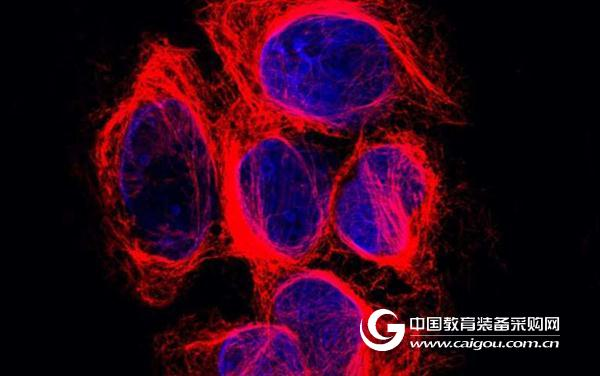For decades, scientists have been looking for an enzyme that separates tyrosine from important parts of the cytoskeleton. Now the Dutch and French scholars have simultaneously identified this mysterious factor, which is essential for understanding the function and division of cells, as well as cancer. The relevant research results were published online in Science on November 16th.

Image source Netherlands Cancer Institute
The so-called cytoskeleton is a structure that keeps cells in shape, can move to different locations, and transport molecules through them. Among them, the long chain called microtubule is an important component of the cytoskeleton and plays a role as a transport molecule.
Studies have shown that the transport of microtubules involves detyrosineization at critical times in the cell cycle. Tyrosine is removed from the tail of the alpha tubulin, a major component of microtubules. For the past 40 years, scientists have been searching for the main factors in this process, but there has been no substantial progress, and it is still unknown that the enzyme can remove tyrosine.
Find the mysterious factor
Now, researchers at the Dutch Cancer Institute have found this mysterious factor and solved the problem.
Joppe Nieuwenhuis and colleagues used their recently developed gene screening methods to find that small vasohibin binding protein (SVBP) is an important component of this process. SVBP binds to a class of proteins called vasohibin (VASH), which keeps VASH stable, and the resulting VASH/SVBP complex has tubulin deacylation activity.
Nieuwenhuis said: "These results are surprising because vasopressin proteins are thought to play outside the cell and until recently it was predicted that these proteins might act as enzymes, but they don't know what their function is."
Whole genome random mutation solving problem
The team discovered these key molecules by using whole-genome random mutations in human cells with only one copy of each gene. Subsequent screening of the cells is due to a random mutation that disrupts the process of detyrosineization. The tubulin of these cells rarely has a de-tyrosine effect, and the mutation of the SVBP gene makes it lose its function. This further experiment confirmed the interaction between the SVBP gene and angiostatin and its effect on the de-tyrosineization of tubulin.
Nieuwenhuis said: "For cell biologists, this may be an important step: we have discovered a problem that scientists have been paying attention to for many years because the process of tyrosineization was discovered 40 years ago. Such knowledge may have To further understand mitosis, cell migration and cancer production. Some invasive frontiers of tumor tissue have been discovered - the most active migration of cancer cells, containing a large amount of de-tyrosineized tubulin. Inhibition of tyrosineization under certain conditions It might be helpful."
French scholars published similar results at the same time
Interestingly, in an article published online the same day, scientists at the Grenoble University and CNRS in France also identified de-tyrosinase using chemical proteomics and confirmed microtubule tyrosine in the brain. The acid carboxypeptidase is a complex of vasohibin-1 (VASH1) and SVBP.
French scholars have found that VASH1 and its homologous protein VASH2, when combined with SVBP, exhibit strong Tyr/Phe-specific carboxypeptidase activity in microtubules. In vitro cultured neurons, inhibition of VASH or SVBP expression reduces the level of de-tyrosinization of alpha-tubulin and results in severe differentiation defects. In addition, inhibition of VASH expression disrupts neuronal migration in the neocortex of the developing brain of mice.
Therefore, the two studies can be said to be the same, using different methods, but they have proved that the vasohibin/SVBP complex is the long-awaited microtubule de-tyrosinase.
Shanghai Chuangsai Technology has excellent performance, interleukin cytokines, fetal bovine serum, electrophoresis equipment scientific instruments, raw material drug standards, chemical reagents, cell culture consumables, Shanghai Chuangsai, mass products special promotions, welcome to inquire!
1 Tier 201 Stainless Steel Dish Rack
1 Tier 201 Stainless Steel Dish Rack,Dish Rack With Tray,1 Tier Dish Rack,Steel Dish Drainer With Tray
Jiangmen Jianghai Jianshang Houseware Co.,LTD. , https://www.jm-jianshang.com